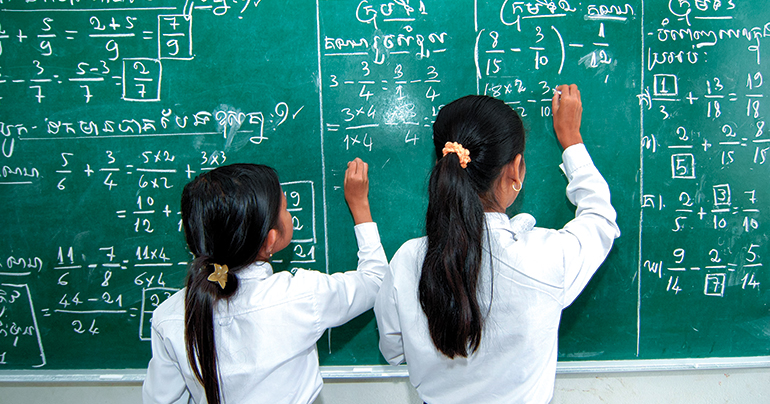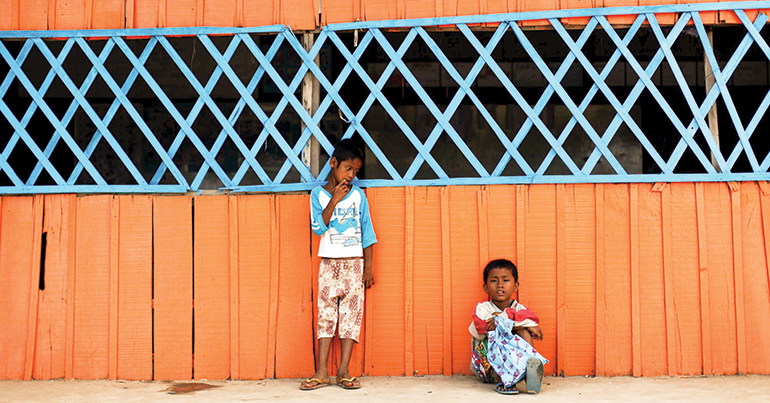EDUCATION FOR ALL
Cambodia has long promised to provide free primary and secondary education to every child within its borders. But with a quarter of a million kids still out of school, how can the Kingdom keep its most vulnerable from slipping through the cracks?
PAUL MILLAR
OCTOBER 1, 2018
G

Cambodian law mandates free primary and secondary education
Three years ago, countless children around the globe woke up to a broken promise. Fifteen years before, as the new millennium dawned, the world came together to pledge that by 2015, every boy and girl would receive a free education to make the difference between a life of poverty or one of plenty.
But an analysis of out-of-school children across Southeast Asia released last year by Unesco was unflinching in its assessment of the global progress towards the much-proclaimed ideal of its Education for All 2000–2015 initiative (EFA for short).
“The sobering reality remains that the world did not fully meet its targets in 2015 despite significant advances,” the report proclaimed. “Only a third of the countries have achieved all of the measurable EFA targets, while a little over half of them have achieved universal primary enrolment. In 2012, an estimated 121 million children and adolescents were still not in school; of them 58 million were of primary school age, while another 63 million were of lower secondary school age.”
This apparent stagnation of global efforts to ensure children from all backgrounds have the right to a quality education has led to a grim reality – for many countries, the report found, the number of children left behind by public education systems is actually growing.
“Alarmingly, recent data suggest that the global number of children and adolescents who have either never attended school or have dropped out has increased to 124 million,” said the report. “Many children worldwide are still being denied their right to quality education.”
Although Cambodia has had much success in ensuring its citizens have access to public education – including the return to the classroom of almost 60,000 children who had not been attending school full time in the past year alone – the Kingdom is still a long way from reaching the UN’s goal of providing compulsory high-quality education for all of its citizens free of charge by 2015.

Keeping children in school has proved to be less costly to society than allowing them to drop out. Photo: Sam Jam
On paper, at least, the Kingdom appears fully committed to providing free education for its people. Cambodia’s constitution, adopted in 1993 after decades of civil war, mandated free primary and secondary public education. Another education law passed in 2007 echoed this requirement for the state to provide a compulsory nine years of free access to public schools. And for those children held back by disability or learning difficulties – by some estimates, as many as one in five – Cambodian law could be counted among the most progressive in the world.
“Aside from these provisions pertaining to free access to all, the State also specifically encourages and promotes access to special education for children with disabilities and outstanding learners who are gifted and/or talented,” the Unesco report said. “The law stipulates that the rights of able-bodied learners should be the same ones enjoyed by those with disabilities.”
But for many children across Cambodia, the noble ideals expressed in the nation’s laws fall painfully short of the reality on the ground. Vorn Samphors, country programme director for the international education nonprofit Aide et Action, which spearheads the Cambodian Consortium for Out of School Children, said that a quarter of a million children in Cambodia continue to slip through the cracks of the Kingdom’s education system.
“The recent survey from the Ministry of Education and Unesco found that over 250,000 out-of-school children [spread across Cambodia’s rural areas],” he told Southeast Asia Globe. “So that needs further collaboration and intervention to provide both access… and quality.”
Samphors said that while the 98% enrolment rate achieved by the Cambodian government was an incredible achievement, that figure failed to capture the many ways the nation’s youth are cut off from the education to which they are entitled.
“There are those who don’t have access,” said Vorn. “There are those who have access but are not enrolled. There are those who have access and they’re enrolled but they don’t attend – their names were in school, but their bodies were in the rice field or in the forest. There are those who have access and are enrolled but because of disability or other factors, their name is there, their body is there, but they cannot learn. Maybe they’re an ethnic minority and the school speaks a different language, or they have a learning difficulty. And then there’s a percentage of children that just drops out.”
Driven by extremely low wages and a culture of bribery, teachers usually demand that students pay an extra fee to attend school – a fee that the majority cannot afford
For many school-age children in Cambodia, a life lived on the edge of poverty forces their families to put their kids to work as soon as they’re strong enough to pull their weight. Girls in particular continue to suffer from deep-seated cultural biases that see education as a man’s prerogative – young women are often pulled from school to shoulder the burden of domestic labour and, once they reach their late teens, marry. And because Cambodia still lacks a strong social safety net, the choice between subsistence and school is no real choice at all. For families struggling to scrape by, “free education” costs them dearly.
Cambodia’s public education system has long been condemned for a raft of informal fees imposed on students by teachers to offset their notoriously low wages. The Marist International Solidarity Foundation, an NGO dedicated to protecting the rights of children, wrote in 2014 that the so-called free public education had long been riddled with hidden costs imposed by struggling teachers on their students.
“Driven by extremely low wages and a culture of bribery, teachers usually demand that students pay an extra fee to attend school – a fee that the majority cannot afford, especially the disabled and most vulnerable children,” the foundation reported to the Human Rights Council. “A 2007 report by the Cambodian NGO Education Partnership revealed that the inability to pay informal fees was the most common reason parents gave for their children dropping out of school.”

Exorbitant “informal fees” (read: bribes) were cited as the biggest reason kids drop out of school
For many rural families that have tilled the soil for generations, though, the benefits of a complete primary and secondary education are still difficult to grasp.
“Something else that pushes them out of school is the understanding of the importance of education among the parents,” Samphors said. “So sometimes, with that limited understanding and commitment and passion about the value of education, they try to force their children into the rice fields instead.”
Our priority has to be investing in those who drop out, those who don’t learn, who face marginalisation at an early age
But beyond the needs of subsistence farmers, the economic benefits of providing children with a sound education are clear. Out-of-school children cost low- and middle-income countries dearly, a 2017 report by the Qatar-funded Educate a Child programme found.
“In absolute terms, the estimated loss [to Thailand] due to out-of-school youth will be US$10.2 billion per year – roughly equivalent to half of Thailand’s total public expenditure on education in 2011,” the report said. By contrast, the economic benefit of enrolling out-of-school youth was nearly equal in value to a year of that nation’s average GDP growth.
Samphors argued that targeted programmes to reach out to children from marginalised communities created major economic and social benefits for society.
“Our priority has to be investing in those who drop out, those who don’t learn, who face marginalisation at an early age, rather than 10, 20 years later when they become a teenager who might cause social problems – or they become the head of a family, and they are not productive and don’t contribute to society,” said Samphors. “Keeping them from dropping out is really a smart and low-cost investment. Left-behind children, out-of-school children, cost the country so much in the long run.”
In other words, it takes a village to raise a child. Samphors said it is essential to instil respect for education in communities where schooling is at best a distraction from the daily struggle to survive.
“The main thing is to educate them about the importance of education, and also… to improve the livelihoods of their families,” he said. “[We need to invest in] all key actors in their learning and education – their parents, the local authorities, the community – and educate, engage and empower them to see that education is the responsibility of everyone.”

No comments:
Post a Comment